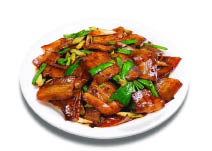Twice-Cooked Pork

Twice-cooked pork ranks top of the culinary pops in Sichuan, the inland province in southwestern China noted for its spicy dishes. This Sichuan specialty is popular throughout China and also in Chinese restaurants overseas. More than half of participants in one public opinion poll voted it the dish most representative of Sichuan cuisine. It is a staple, with familial variations, in every Sichuan household.
Twice-cooked pork originates in the tradition of making sacrificial offerings to the gods. In ancient times, members of the imperial family and their offshoots would offer up sacrifices of beef, lamb and pork. The common people, for economic reasons, would opt for the cheaper cut of streaky hindquarter pork, boiled till 70 to 80 percent done. Rather than waste the meat after the ritual had been performed, thrifty Chinese ancestors would stir-fry it with garlic shoots, red pepper and turnip to enjoy with family and friends.
The cooking technique is simple and all ingredients are distinctively local:
Thinly slice the pork. Add a dash of colza oil to a generous helping of lard in a hot pot, heat and mix the two, and stir fry the pork slices till they curl at the edges. Add to the pot a spoonful of bean sauce à la Pixian County (close to Chengdu, capital city of Sichuan Province), then sweet sauce, soy sauce and some garlic shoots. When cooked and ready to serve, add a little heated oil to give the meat, green garlic shoots, red pepper and turnip an appetizing sheen.
In the late Qing Dynasty a retired official surnamed Ling modified the recipe by steaming rather than boiling the pork before stir-frying it. Prepared this way the meat is more succulent and has a better color. This method also makes for a more nutritious dish, as it conserves the soluble protein while retaining the pork’s original distinctive taste.

